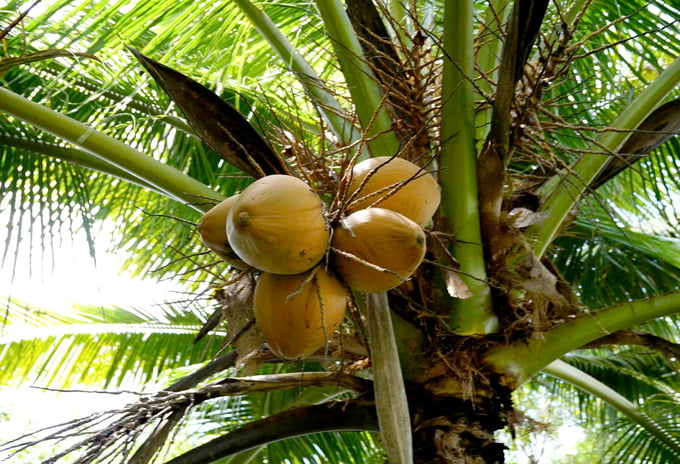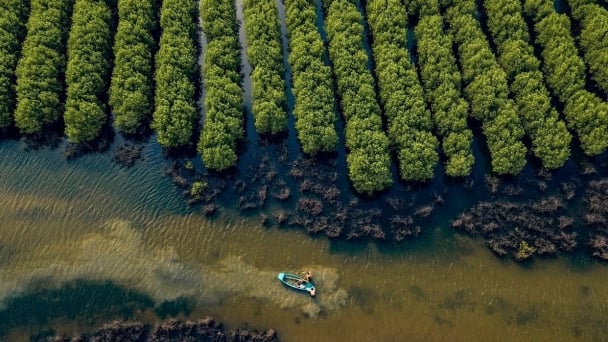June 16, 2025 | 16:13 GMT +7
June 16, 2025 | 16:13 GMT +7
Hotline: 0913.378.918
June 16, 2025 | 16:13 GMT +7
Hotline: 0913.378.918

Fresh coconut exports currently account for 20 to 25% of the country’s total coconut export value. Photo: Nguyen Thuy.
According to Cao Ba Dang Khoa, General Secretary of the Vietnam Coconut Association, Vietnam’s fresh coconut export sector has only emerged and developed in the past eight years. However, the sector has exhibited significant growth, increasing tenfold over this timeframe.
To date, Vietnamese fresh coconuts have been exported to over 40 countries around the world, with export revenues reaching approximately 250 million USD in 2023, which represent 20 to 25% of the country’s total coconut export value.
However, this rapid growth has led to challenges for the business community in terms of planning, procurement, and processing. Namely, companies face significant challenges in purchasing large quantities of fresh coconuts that meet uniform standards with regards to variety, size, and quality. Furthermore, there is a lack of concentrated coconut raw material areas.
Due to the lack of concentrated production areas for specific export coconut varieties, exporting companies may face significant challenges when they secure a contract to export multiple containers of a single coconut variety. As a result, businesses must purchase all available types of coconuts within the same region. Subsequently, they must sort the acquired coconuts to meet their partner's requirements.
Consequently, key raw material areas play a significant role in a sustainable coconut export sector. Notably, several businesses have invested in coconut farms, with each company owning between 100 and 500 hectares. Consequently, similar-sized coconut farms have emerged across Vietnam's southwest border, specifically in the districts of Vinh Hung and Moc Hoa in Long An Province and a few districts in Tay Ninh Province.
Similarly, several coastal provinces of Central Vietnam, such as Khanh Hoa, Phu Yen, and Binh Dinh, also house coconut farms that cover from 40 to 50 hectares to nearly 100 hectares.

Key raw material areas are essential for the sustainable development of the coconut industry. Photo: Nguyen Thuy.
However, a detailed development plan for coconut production, particularly in the Mekong Delta, the largest coconut-growing region in the country, is necessary to fully capitalize on market opportunities, boost fresh coconut exports, and promote the sustainable growth of the coconut industry. With this plan, businesses can make strategic investments to establish concentrated coconut raw material areas.
In addition, the business community and coconut farmers must both meet the regulations and standards for various markets to expand their export activities, with an immediate focus on the Chinese market. This development will require the issuance of production unit codes, packaging facility codes, and the implementation of necessary standards to ensure that Vietnamese coconuts meet the requirements of the Chinese market. Moreover, stakeholders must ensure traceability for exported fresh coconuts.
Nguyen Dinh Tung, General Director of Vina T&T Group, emphasized that key raw material areas with production unit codes and traceability are the most important factors for stable and sustainable fresh coconut exports.
Furthermore, stakeholders must organize production activities within these raw material areas to maintain uniform coconut quality, ideally with single-variety farms. For example, a Siamese coconut-only production area should exclusively grow this variety to improve quality and efficiency. Mixed-variety farms may pose significant difficulties for export businesses, as each market or customer group has distinct preferences for coconut types and coconut water flavors.
On the other hand, stakeholders must make an effort to enhance the production capacity of Vietnam's coconut industry to meet the increasingly strict requirements of the market. As a result, the coconut business community must coordinate to comply with high-quality standards and other requirements. This collaboration will guarantee that, once fresh coconuts leave the Vietnamese borders, the overall quality of Vietnamese coconuts will be preserved, regardless of the company that exports them.
On August 19, the Ministry of Agriculture and Rural Development and China's General Administration of Customs (GACC) signed a protocol on the export of fresh coconuts to the Chinese market. According to Deputy Minister Hoang Trung, this collaboration presents a significant opportunity to restructure production, enhance cooperation, and expand market access.
"China consumes more than 4 billion coconuts annually, including 2.6 billion for direct consumption and 1.5 billion for processing. However, their domestic production capacity is insufficient, presenting a major opportunity for Vietnam," he added.
Translated by Nguyen Hai Long
![Turning wind and rain into action: [4] Bringing climate bulletins to remote and isolated areas](https://t.ex-cdn.com/nongnghiepmoitruong.vn/608w/files/linhnhp/2025/06/14/1152-z6704423696987_15fd32ffc26d590d204d520c9dac6786-nongnghiep-151141.jpg)
(VAN) The Vietnam Agriculture and Nature Newspaper interviewed Mr. Vu Thai Truong, Acting Head of Climate Change and Environment at UNDP Vietnam, to gain deeper insight into how climate bulletins are delivered to farmers.

(VAN) In Tien Giang, a high-tech shrimp farm has developed a distinctive energy-saving farming model that has yielded promising results.
![Turning wind and rain into action: [3] 300.000 farmers benefit from agro-climatic bulletins](https://t.ex-cdn.com/nongnghiepmoitruong.vn/608w/files/news/2025/06/12/e5a48259d6a262fc3bb3-nongnghiep-125122.jpg)
(VAN) The agro-climatic bulletin has become a valuable tool for farmers in the Mekong Delta. After more than five years of implementation, the initiative is gradually being expanded nationwide.
![Turning wind and rain into action: [2] Providing forecasts to the people](https://t.ex-cdn.com/nongnghiepmoitruong.vn/608w/files/news/2025/06/12/e5a48259d6a262fc3bb3-nongnghiep-103927.jpg)
(VAN) In addition to improving the quality of hydrometeorological forecasts, putting forecast bulletins into practical use is crucial for production and disaster prevention.

(VAN) Blue carbon is receiving attention for its rapid absorption capacity and vast potential. It represents a promising nature-based solution to respond to climate change.
/2025/06/11/3507-1-161904_583.jpg)
(VAN) Seagrass beds and coral reefs serve as 'cradles' that nurture life in the ocean depths, creating rich aquatic resources in Vietnamese waters.
![Turning wind and rain into action: [1] Forecasting for farmers](https://t.ex-cdn.com/nongnghiepmoitruong.vn/608w/files/news/2025/06/11/e5a48259d6a262fc3bb3-nongnghiep-111919.jpg)
(VAN) Weather is no longer just a matter of fate. Forecasts have now become an essential companion for farmers in every crop season.